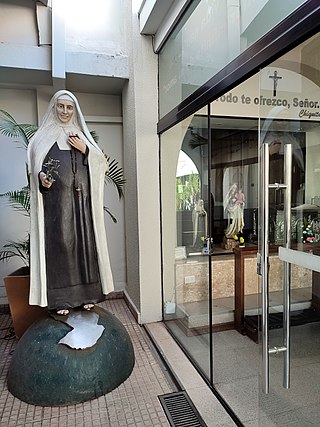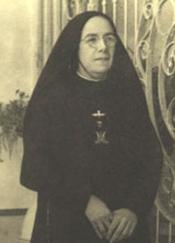Related Research Articles

Anne of Saint Bartholomew - born Ana García Manzanas - was a Spanish Discalced Carmelite. She was a companion to Saint Teresa of Ávila and led the establishment of new monasteries of in France and the Lowlands. Anne sometimes struggled with her superiors as she set about setting new convents and holding her position as a prioress while later settling in the Spanish Netherlands where she opened a house and remained there until she later died. She was a close friend and aide to Saint Teresa of Ávila and the saint died in her arms in 1582.

Vincenzo Romano – born Vincenzo Domenico Romano – was an Italian Roman Catholic priest born in Torre del Greco in Naples. Romano was a parish priest of the village of Herculano who was noted for his simplistic and frugal manner of living and for his great care of orphans. But the French invaders in his area in addition to some of the Italian political groups oppressed him and his work. The people of Torre del Greco granted him the nickname "The Worker Priest" due to Romano's tireless work with the poor and for his commitment to the social needs of all people in the Neapolitan region. He was also noted for his efforts in rebuilding much of Naples following the 1794 eruption of Mount Vesuvius in which he himself cleared rubble and organized rebuilding efforts.
Maria Candida of the Eucharist, OCD was an Italian Discalced Carmelite. Barba desired to become a nun in her adolescence but her parents forbade this and she was forced to wait two decades to realize her dream; she entered the order after her parents died, though she alienated her brothers in the process. They refused to ever see her due to their resentment of her decision. Barba became a noted member of her convent in Ragusa and she served as prioress. Her devotion to the Eucharist was a focal point for her spiritual thinking and her own life. Pope John Paul II beatified Barba in Saint Peter's Square on 21 March 2004.

Ana de Jesús, known in English as Anne of Jesus, was a Spanish Discalced Carmelite nun and writer. She was the founder of the Carmelite reform and a close companion of Teresa of Ávila, and served to establish new monasteries of the Order throughout Europe. Known as a mystic and for her writings on prayer, she has been beatified by the Catholic Church.
Giuseppina Gabriela Bonino, also known by her religious name Giuseppina Gabriella of Jesus, was an Italian Roman Catholic professed religious and the founder of the Suore della Sacra Famiglia di Savigliano. Bonino dedicated her life to the ill and to orphans and did this in drawing upon her own experience in tending to her ailing father and to orphans in her hometown - all this prior to and after the establishment of her religious congregation.

María de las Maravillas de Jesús, OCD, in some contexts known as Maravillas de Jesús, was a Spanish Discalced Carmelite. She founded several houses of her order and even set one up in India after serving a brief exile with other Carmelites due to the outbreak of the Spanish Civil War.

Blessed Maria Teresa of Saint Joseph, DCJ, was a German religious sister and the founder of the Carmelite Daughters of the Divine Heart of Jesus. Tauscher worked in Cologne and was removed from her position after she converted to Roman Catholicism in 1888 so founded a congregation in the Netherlands upon choosing the Carmelite charism for her life.

María López de Rivas Martínez, OCD, in religion María of Jesus, was a Spanish Discalced Carmelite. She was beatified on 14 November 1976.

Maria Karłowska – in religious Maria of Jesus Crucified – was a Polish Roman Catholic professed religious and the founder of the Sisters of the Divine Shepherd of Divine Providence. Karłowska worked with poor and abandoned people with an emphasis on girls and also tried to aid prostitutes avoid such a life and build another kind of life so used her order to reach out to such people to render assistance.

Maria Crocifissa Curcio, CMST was an Italian Catholic religious sister who established the congregation of the Carmelite Missionary Sisters of Saint Therese of the Child Jesus.

Maria Grazia Tarallo, CAE was an Italian Catholic member of the Crucified Sisters Adorers of the Holy Eucharist. She was well known for her charitable nature as well as her strong devotion to the Eucharist.

Maria Scrilli, religious name Maria Teresa of Jesus, was an Italian religious sister who established the Sisters of Our Lady of Mount Carmel.

Caterina Sordini was an Italian Roman Catholic professed religious that established the Sisters of Perpetual Adoration, in latin Adoratrices Perpetuae Sanctissimi Sacramenti, devoted to the Eucharist. She assumed the religious name of "Maria Maddalena of the Incarnation" when she became a member of the Third Order of Saint Francis during her adolescence.

María del Tránsito Cabanillas was an Argentine Roman Catholic Franciscan tertiary and the founder of the Franciscan Tertiary Missionary Sisters. Upon her solemn profession she assumed the religious name María del Tránsito de Jesús Sacramentado. Cabanillas was beatified on 14 April 2002.

María Guggiari Echeverría, OCD, was a Paraguayan Discalced Carmelite who served in her adolescence as a member of Catholic Action.

Marianna Fontanella, OCD, also known as Maria degli Angeli or Mary of the Angels, was an Italian Catholic member of the Discalced Carmelites. Fontanella studied with the Cistercians as a child and entered the Discalced Carmelites despite the protests of her mother and siblings. She soon became a noted abbess and prioress and in 1703 inaugurated a new convent of which she herself oversaw the establishment.
Elvira Moragas Cantarero, religious name María Sagrario de San Luis Gonzaga, was a Spanish nun of the Order of the Discalced Carmelites of the Blessed Virgin Mary of Mount Carmel.
Maria Gargani, religious name Maria Crocifissa del Divino Amore,, was an Italian member of the Secular Franciscan Order and the founder of the Sisters Apostles of the Sacred Heart. Gargani was involved with Catholic Action during her teaching career but is best known for having been a close friend and correspondent with Pio from Pietrelcina from World War I until the saint's death in 1968; the saint wrote a total of 67 letters to Gargani during this period.

Julia Navarrete Guerrero - in religious Julia of the Thorns of the Sacred Heart - was a Mexican Roman Catholic professed religious and the founder of the Misioneras Hijas de la Purísima Virgen María. Navarrete first felt called to promote religious education from her adolescence while still a student before moving to the national capital where she met the Jesuit priest Alberto Cuscó who formed her in the religious life. Not long after this she became a nun and set about founding schools and missions across both Mexico and the United States where she first started in Texas. Her brother Juan María Navarrete Guerrero became the Archbishop of Hermosillo and whose beatification process is ongoing.
References
- 1 2 3 4 5 6 "Biographies of New Blesseds - 2008". EWTN. 2008. Archived from the original on 8 January 2017. Retrieved 12 April 2016.
- 1 2 3 "Blessed Maria Giuseppina of Jesus Crucified". Santi e Beati. Retrieved 12 April 2016.
- 1 2 3 4 "Bl. Giuseppina Catanea (1894-1948)". Holy See. Archived from the original on 31 May 2016. Retrieved 12 April 2016.
- ↑ Index ac status causarum beatificationis servorum dei et canonizationis beatorum (in Latin). Typis polyglottis vaticanis. January 1953. p. 161.